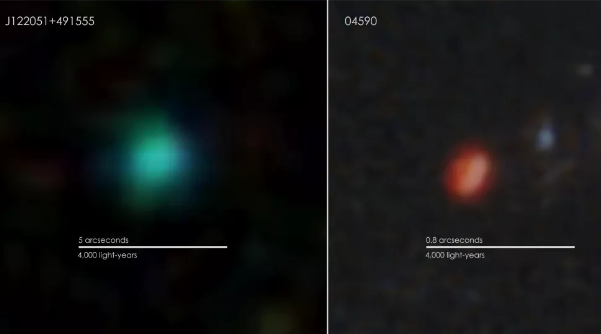At the Shanghai Astronomical Observatory (SHAO) of the Chinese Academy of Sciences, astronomers and their collaborators have discovered nearly five Green Pea galaxies with double-peaked narrow lines among almost 1,550 Green Pea galaxies.

At left, a "green pea" galaxy located about 170 million light-years away; at right, a "green pea" galaxy that the James Webb Space Telescope sees as it was 13.1 billion years ago. (Image credit: SDSS and NASA, ESA, CSA, and STScI)
Such objects might form from dual active galactic nuclei (AGN) mergers, possibly disclosing the co-evolutionary characteristics of a unique class of supermassive black holes and high-mass galaxies.
The study was reported in the Monthly Notices of the Royal Astronomical Society journal on July 19th, 2023.
Green Pea galaxies have been named for their green and small optical appearance and are defined by strong emission lines, especially the doubly ionized oxygen [OIII] emission line.
They are low-redshift galaxies with low metallicity, small mass, and active star formation. They are known to be analogs of early galaxies in the close universe. Few show signs of AGN activity, indicating the actively accreting supermassive black holes present in their nuclei.
Systematic searches and studies of Green Pea galaxies could help understand the formation and evolution of early galaxies. AGN samples present inside such galaxies offer deep knowledge of the co-evolution of early supermassive black holes and also their host galaxies.
A Green Pea galaxy sample was utilized by the scientists from the Extra-galactic Survey of the Large Sky Area Multi-Object Fiber Spectroscopic Telescope (LAMOST).
At present, it is the biggest collection of Green Pea galaxy spectra, surrounding almost 1,550 Green Pea galaxy spectra, which is over double the number of Green Pea galaxies determined in the Sloan Digital Sky Survey (SDSS).
By analyzing the emission line profiles of the LAMOST and SDSS spectra, the scientists found around five Green Pea galaxies with double-peaked narrow lines. By using multi-band photometry and optical spectral diagnostics, the researchers dependably verified the AGN activity present in this sample.
Depending on emission line profiles and optical morphologies, the physical origin of the double-peaked profiles in such galaxies is more probably attributed to dual AGN mergers instead of outflows or accretion disks.
These five galaxies have a narrow line width for each component and lack obvious inclination. Therefore, the double-peaked emission lines are less likely originated from outflows or gas disks.
LIN Ruqiu, Study First Author and Ph.D. Student, Shanghai Astronomical Observatory, Chinese Academy of Sciences
“These five Green Pea galaxies exhibit stronger [OIII] equivalent widths compared to double-peaked emission line galaxies in Type 2 AGN. The underlying cause of this phenomenon may be related to galaxy mergers in the early universe,” said Professor ZHENG Zhenya from SHAO, corresponding author of the study.
Zhenya added, “The upcoming new phase of the LAMOST Extra-galactic Survey holds promise for providing us with more samples of such unique galaxies, further unraveling the co-evolution of massive galaxies and supermassive black holes.”
Journal Reference
Lin, R., et al. (2023) Discovery of five Green pea galaxies with double-peaked narrow [O III] lines. Monthly Notices of the Royal Astronomical Society. doi.org/10.1093/mnras/stad1857